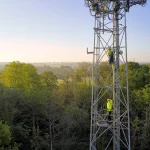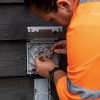Scientists Have Broken One of the Biggest Limits in Fibre Optic Networks
One of the biggest limitations in ultrafast fibre optic communications is that even optical signals can weaken over long distances, which requires expensive electronic regenerators (repeaters) to be placed along the route to boost the signal. But what if you didn’t need those? Future networks could be both faster and cheaper.
Last year a research group (Photonics Systems Group) working out of the University of California in San Diego (USA), specifically its Qualcomm Institute, published a paper that theorised how it might be possible to pre-empt “the distortion effects that will happen in the optical fiber” and in so doing you could also remove the interference.
Advertisement
Nikola Alic, co-Author of the Research Paper, said:
“Today’s fiber optic systems are a little like quicksand. With quicksand, the more you struggle, the faster you sink. With fiber optics, after a certain point, the more power you add to the signal, the more distortion you get, in effect preventing a longer reach.
Our approach removes this power limit, which in turn extends how far signals can travel in optical fiber without needing a repeater.”
Until now it has remained a significant roadblock that any increase in optical data transmission rates, beyond a threshold power level, would effectively distort the information travelling inside the cable. But the same team that last year theorised a solution to this problem has now proven their work in a live experiment.
The team were able to boost the power of their transmission some 20 fold and push data over a “record-breaking” 12,000km (7,400 miles) long fibre optic cable. Amazingly the data was still intact at the other end and that was achieved without using repeaters and only needing standard amplifiers (the cost of repeaters plays a big part in the overall expense of such networks).
How did they do it?
Information sent down fibre optic cables is generally split into multiple channels of communication (up to 200 can be used in modern cables), which each operate at different frequencies (i.e. light can be split into different colours [red, green, blue etc.] and this is a good way of visualising how the different channels are separated).
Essentially what the UC San Diego researchers did was to develop a system (frequency comb) that acts a bit like a concert conductor, which is the person responsible for tuning multiple instruments in an orchestra to the same pitch at the beginning of a concert.
Advertisement
The engineers then used this comb to synchronize the frequency variations of the different streams of optical information (optical carriers), which can compensate in advance for the crosstalk interference (this will be familiar to those who have been reading about FTTC / VDSL2 Vectoring technology on copper cables) that can occur between multiple communication channels within the fibre optic cable. The frequency comb also ensures that the crosstalk interference is reversible.
In some approaches this calculation of pre-distortion is already done with existing systems, but not across all the channels together. Apparently the experimental setup only tested the approach with 3 and 5 optical frequency channels, although the researchers claim that their system could be used in significantly larger setups with many channels. This is important to know since many of today’s primary capacity carrying cables use around 30+ channels.
Stojan Radic, UC San Diego Professor, said:
“Crosstalk between communication channels within a fiber optic cable obeys fixed physical laws. It’s not random. We now have a better understanding of the physics of the crosstalk. In this study, we present a method for leveraging the crosstalk to remove the power barrier for optical fiber.
Our approach conditions the information before it is even sent, so the receiver is free of crosstalk caused by the Kerr effect.”
The solution, assuming it propagates well into an existing commercial environment (the cost of transmitters might still be an issue), suggests that the future cost of both national and international data capacity could be about to fall. It may also delay the need to build new cables and stave off fears of a future “capacity crunch“.. at least for a little longer, which is always welcome.
At the same time by improving the transmission quality with this method you also make it possible to sustain faster speeds over longer distances, although this is more relevant to international transmissions.
Advertisement
Home users won’t be demanding more speed from 1000Mbps FTTH/P lines anytime soon (not that many people have those) and in any case domestic services are usually delivered over shorter distances where issues like the one explain above are less of a problem.
Mark is a professional technology writer, IT consultant and computer engineer from Dorset (England), he also founded ISPreview in 1999 and enjoys analysing the latest telecoms and broadband developments. Find me on X (Twitter), Mastodon, Facebook, BlueSky, Threads.net and Linkedin.
« UPDATE3 BT’s Broadband Rollout Deal for Devon and Somerset Collapses

















































Comments are closed